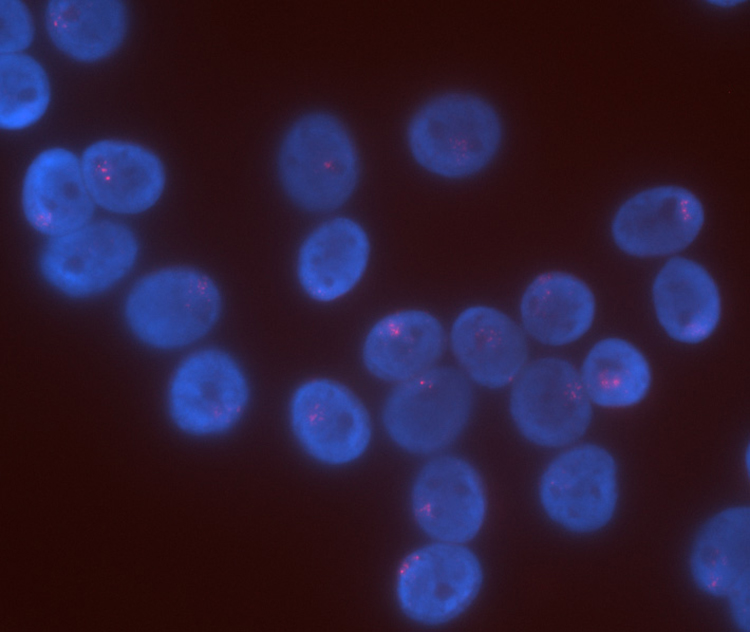Sex Differences May Influence Lung Injury and Repair

Sex differences in gene expression in alveolar type 2 (AT2) cells may underlie sex biases in the prevalence and severity of lung diseases, according to a study led by University of Pennsylvania scientists and published in the journal Stem Cell Reports.
“Our study is the first to compare male and female AT2 cells for gene expression, and our findings suggest that there are likely sex differences with lung repair following viral-induced injury,” said Montserrat Anguera, co-senior author of the work and an associate professor in Penn’s School of Veterinary Medicine.
COVID-19 commonly presents as pneumonia, with those most severely affected progressing to acute respiratory distress syndrome (ARDS), a condition associated with a mortality rate as high as 45%. As previously observed with related coronaviruses, older males are at significantly higher risk for severe or fatal outcomes from COVID-19. Sex differences exist for many lung diseases, but the mechanistic basis remains unclear.
“We started this project during the beginning of the pandemic, and wondered whether X-chromosome inactivation (XCI) might contribute toward this sex bias,” Dr. Anguera said. “We realized that the SARS-CoV-2 virus first encounters AT2 cells in the lung, and that the virus enters cells through the angiotensin-converting enzyme 2 (ACE2) receptor, which is located on the X chromosome.”
XCI is a process by which one copy of the X chromosome is inactivated in female mammals. The inactive X chromosome is silenced by being packaged into a transcriptionally inactive structure called heterochromatin. XCI prevents female mammals from having twice as many X-chromosome gene products as males, who only possess a single copy of the X chromosome.
In the new study, Dr. Anguera, co-senior author Andrew Vaughan of Penn Vet, and colleagues investigated XCI maintenance and sex-specific gene expression profiles using male and female AT2 cells. They showed that approximately 68% of expressed X-linked genes in mouse AT2s escape XCI. These genes include ACE2, which serves as the entry point into cells for SARS-CoV-2, but is also involved in lung repair.
There were genome-wide expression differences between male and female AT2s, likely contributing to sex differences in lung injury and repair in multiple settings, including COVID-19 and ARDS. Taken together, the findings demonstrate that AT2 cells have the highest levels of XCI escape for mouse cells reported to date, and support a renewed focus on AT2s as a potential contributor to sex-biased differences in lung disease.
In addition, the results also showed that AT2 cells, similar to immune cells, do not strictly follow the typical rules of XCI. Female AT2 cells, Dr. Anguera said, lack some of the epigenetic modifications—tags and other molecules that alter gene expression—usually prevalent on the inactive X chromosome due to the X chromosome inactivation process.
“These include the long noncoding RNA Xist and heterochromatic histone modifications H3K27me3 and H2AK119-ubiquitin,” Dr. Anguera said. “Because the inactive X chromosome in female AT2 cells has less epigenetic marks, this enables more gene expression chromosome-wide, including the ACE2 gene.”
For now, it remains an open question whether ACE2 escapes inactivation in human AT2 cells. According to the authors, this is a likely scenario because there are significantly higher numbers of X chromosome inactivation “escape” genes in human cells compared to mouse cells.
Moving forward, the authors plan to investigate how SARS-CoV-2 infections affect expression from the inactive X in AT2 cells. They also will continue to study how other cell types that exhibit conventional XCI maintenance regulate expression from the X chromosome.
“Our findings open the door to future work investigating the genetic and epigenetic basis, residing within the X chromosome, for sex differences with immune responses to inhaled viruses,” Dr. Anguera said. “They also suggest that AT2 cells function differently depending on whether you are biologically male or female.”
Adapted from a Penn Today article by Katherine Unger Baillie, January 12, 2023.
